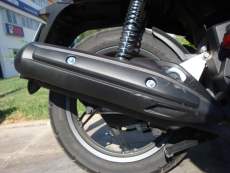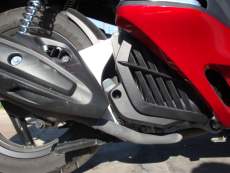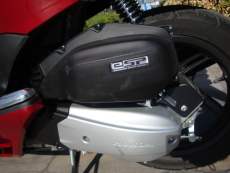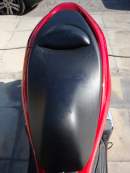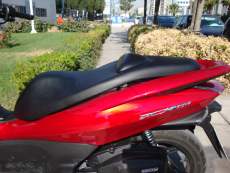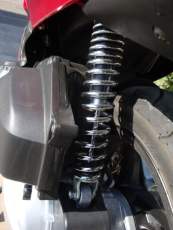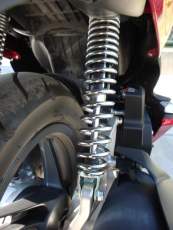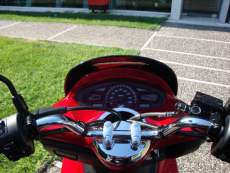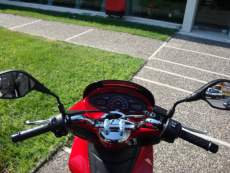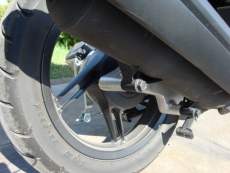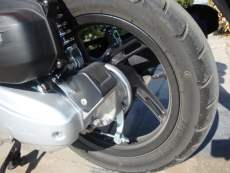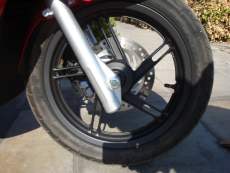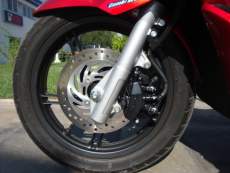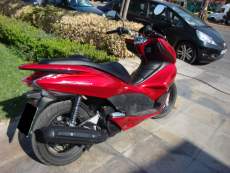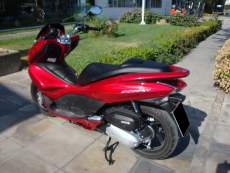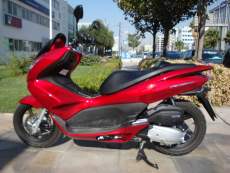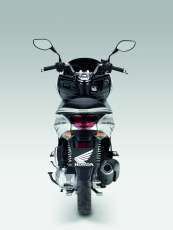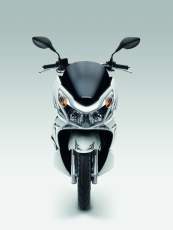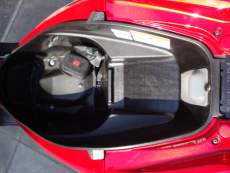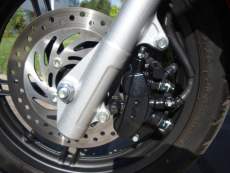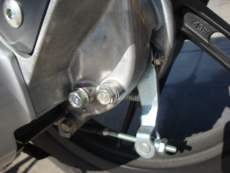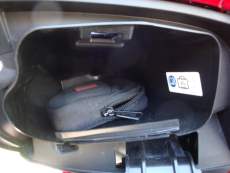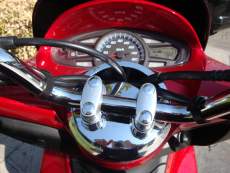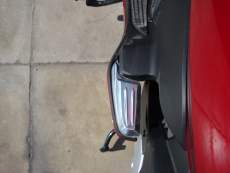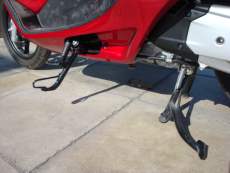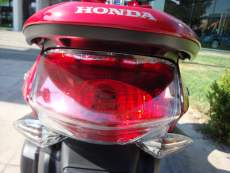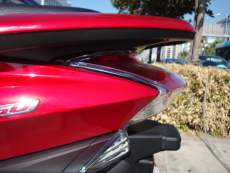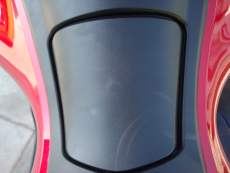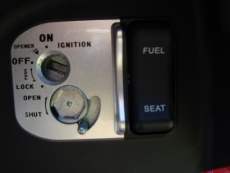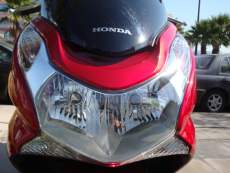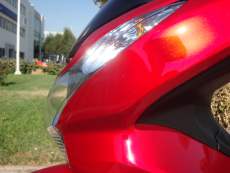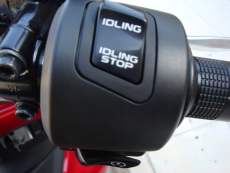Honda PCX 150 idle stop (2012-present): Urban frugality
Engine: The liquid cooled 153 c.c. engine provides 13.4 bhp/ 8500 rpm and 1.42 kgm/5250 rpm (10.3 lbs ft) torque, claimed figures. Actually pressing the rear brake lever is necessary in order to start the engine. The engine sound is discreet yet angry, nothing really to do with the smaller and quiet 125 c.c. version. However compared with the smaller engine, the punch provided on everyday use is quite more powerful.
Thus under full throttle acceleration itĒs very fast up to the speed of 40 Km/h, (25 mph), fast up to 60 Km/h, (37 mph), relatively fast up to 80 Km/h, (50 mph), while the speed of 100 km/h (62 mph) is preserved even on slight uphill roads. The top indicated speed of 110 Km/h, (68 mph), rider alone, is achieved moderately. Its about the same with the top speed of the smaller 125 c.c. version, despite the power increase by 2 bhp.. The top speed is restricted by a really discreet speed limiter.
Idling stop may be deactivated by the switch on the right handlebar. ItĒs a function where each time that the engine is started initially at the beginning of a ride and the scooter exceeds the speed of 8 Km/h it is activated. After 3 seconds of engine inactivity at idle rpm and zero speed, engine is switched off, which increases frugality when the scooter is stopped, e.g. at traffic lights.
When the engine is switched off by the idle stop, a warning light A, is blinking on the display. This symbol is continuously lit during the ride. Thus the rider is being calmed by mother Honda seeming to repeat at every traffic light: “Until you feel confident enough, you are reminded by this blinking symbol A, that as soon as you turn the throttle on, the engine will automatically start without any hesitation”. Certainly it proves right at every traffic light, applying the throttle after inactivity.
Thus the fastest green light getaway occurs if rider turns and holds steady the throttle on, in one complete movement, without a hint of delay. At the opposite, a fast response rider will be the first to start from traffic lights like this. If rider turns on and off the throttle at traffic lights, at least once in 3 seconds and idle stop is turned on, engine will not be deactivated.
Consecutively idle stop system works really well and discreetly, rider gets easily used to it and will not be bothered again riding the PCX. The differences regarding performance between the two engine versions is evident, the larger capacity engine is punchier, which is not always necessary to all riders. This is in case of solely downtown use, or if rider has the notion that highway rides are easier now (if it is allowed to do so). An indicative average fuel consumption figure is 3 l/100 km ( 94 mpg Imperial).
Riding position: The seat is low, 761 mm (30 in.) and relatively narrow, especially at the front. Thus all riders will step firm their feet on the ground. A stop is created at the rear of riderĒs section on the saddle.
RiderĒs feet are placed at a specific position on the scooterĒs floor, while they are protected to the front and sides by the leg shield. The scooterĒs weight is 129 kgs (284.5 lbs) nominal kerb. Its lighter than what someone would expect from a 150 c.c. scooter, just 1 kg (2.2 lbs) heavier than the 125 c.c. version.
The width of the scooter is narrow, the front end seems low due to the lack of a screen, thus rider gets a feeling that she/he is positioned rather on top of the scooter. However riding position is mostly in the PCX, the height of the handlebar counterbalances this weird feeling. The upright yet comfortable riding position, the tall handlebar, together with a lot of chrome at the handlebar area, reminds something of a cruiser…
On the road: Suspensions are soft for the scooter class standards. IRC OE tires are mounted with dimensions 90-90-14 to the front and 100-90-14 to rear. There are better choices around especially on low friction factor roads use.
The soft-qualitative suspensions and the neutral riding position, result to comfortable town rides. The tunnel created by the frame between riderĒs legs is not very convenient on frequent rides, since rider will need to lift a foot over the saddle prior to every ride.
On downtown rides the steering radius is exceptional and combined with the narrow scooter width, it will permit the PCX to take advantage of every gap in traffic.
Filtering is superb due to the small width, although the height of the handlebar and scooterĒs mirrors is the same with carsĒ and SUVsĒ mirrors respectively.
The comfort provided by the rear suspension is better than the standards of the category. Thus the PCX produces a marginally increased comfort compared to scooters featuring a 14 inch wheel at the rear, although any large pothole will be eventually felt by the rider. As in the majority of the scooters, on decent tarmac roads, riding is superb.
On B-roads handling is typical for the standards of the 14 inch wheeled category scooters. ItĒs a genuinely agile scooter, the performance provided is very vivid.
At the fast pace on low friction factor roads, rider has to change the OE tires as feedback is reduced while confidence to the rider is diminished. Compared to the Honda SH 150 a very noticeable gap is formed concerning riding and especially, the handling. On high friction factor roads there is no issue for the rider.
On the highway at a speed of 100 km/h (62 mph) or faster, the PCX 150 is not as stable as the 16 inch wheeled scooters. Thus the electronic speed limiter is not considered to be a disadvantage. However the average top speed is adequate for very short rides on the highway, wherever that is allowed of course.
On dirt roads the small wheels and the on-road orientation of the PCX are evident, diminishing any off road potential of the scooter. Every surface imperfection is transmitted to the rider, dirt rides are not calm or confident. Naturally, the PCX is not meant for a use like that.
The brakes are combined, their operation is user friendly. Specifically the 220 mm front disc brake featuring a three piston caliper is quite powerful providing good initial bite, average feedback though. Thus on low friction factor streets, it will require some additional caution by the rider on emergency braking, due to the OE tires.
The rear 130 mm drum brake provides average stopping power and feedback to the rider, it is also quite linear. On high friction factor roads, braking is very good.
Model history/versions/optional/reliability/build quality: The PCX 125 was introduced in 2010. The 150 c.c. version was launched in 2012. Honda decided to keep both scooters on the market.
Since 2012, the new improved engine eSP,
(enhanced Smart Power) is featured on both versions.
A large full face helmet may be stored under the seat, leaving some more free space, suitable for a rain coat as an example. There is a secondary storage space at the legshield. ItĒs the gloves compartment, suitable for e.g. sun glasses and a wallet. It cannot be locked though. An optional 26 l topbox is available.
In order to refuel the scooter or to open the saddle, the key must me turned to the “opener” position and then rider has to press the seat/fuel switch. The lock features an additional protective cap. There are not any reliability issues. The manufacturing country is Thailand. Build quality is very good, the finish is superb.
Comments:
The PCX combines several technological solutions aiming in fuel economy and in this field it excels for the category standards, without any functional disorders.
Compared to the smaller 125 c.c. version, the PCX 150 provides a punchier performance due to the acceleration mostly. Fuel consumption is deteriorated though on downtown everyday use, while in terms of riding the two scooters are the same. Thus its not considered to be generally a much better scooter suitable to any rider, although its marginally more expensive, by 200 Euros.
The red color of the scooter tested is nice and qualitative, due to the metallic particles in the paint. On a shade it is kind of discreet, under the sun though it is nice providing the advantage to the rider to locate the scooter from a great distance! At least if there are not many red PCX 150 scooters parked close by!
Price : 2790 Euros
+ Idle stop system- frugality
+ Price
+ User friendly
- Average handling given the 14 inch wheels scooters standards.
More, specifications, (IT)
More, specifications



